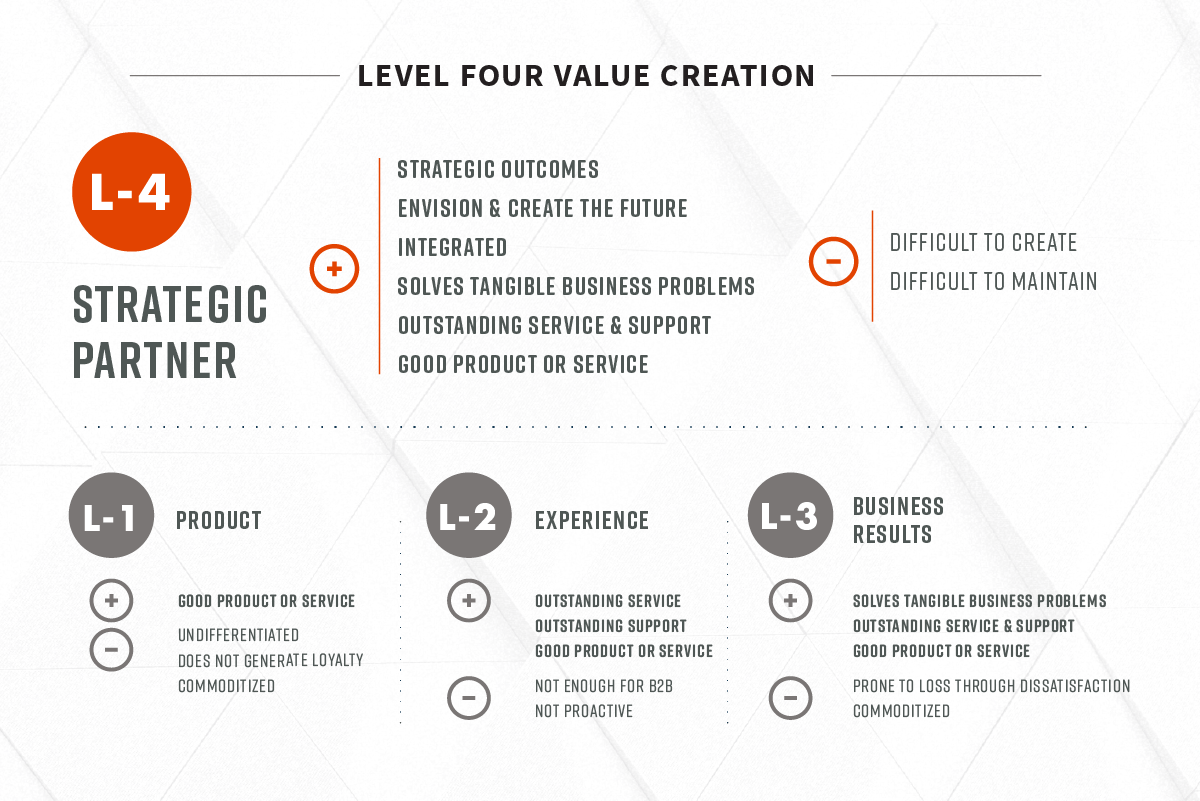The concept of Level 4 value creation helps salespeople recognize what prospects and clients need from them, even if they rarely get what they need. Essentially, Level 4 value focuses on the strategic outcomes the client needs that exceed their known problem. Instead of trying to inflate a product and/or service by labeling it a “solution,” as the legacy approach does, pursuing Level 4 value requires salespeople to move beyond the things they sell to consider the client outcomes they can create. This post will teach you to recognize shortcomings in your value creation and how to get closer to Level 4.
Understanding a Level Four Value Proposition
In Eat Their Lunch: Winning Customers Away from Your Competition, I remind salespeople that they are the value proposition in their sales conversations—not their company, product, service, price, or client portfolio. Improving your value proposition, thus, means starting the sales conversation at the strategic level by discussing what matters most, including the root causes of the client's inability to produce better results.
Many salespeople recognize the value of this concept instinctively. Once, on an airplane, the CEO of a company was looking over my shoulder while I worked on a slide deck. On my screen was the graphic you see here, illustrating the concept of Level 4 value. He asked me what I did, and then described his sales team as being "level one," the way we describe a transactional approach. When I started to explain the four levels, he stopped me, explaining that the image was all he needed to reassess his company's approach.
Along similar lines, some salespeople recognize that changing the order of the sales conversation is significant, something that (at least for now) creates a novel and powerful form of differentiation inside the sales conversation. Starting with the traditional, tired, and completely commoditized experience immediately signals the prospective client that they are unlikely to learn anything new—and certainly nothing that might help them make a better decision for their business. Unfortunately, because many salespeople have never even witnessed a sales call that starts at Level 4, the concept is lost on them.

Consultative Selling: How You Fall Short
Ask a salesperson to tell you what make them consultative, and you are certain to hear something about "asking questions," followed by some gibberish about not being "pushy." There is little doubt that good questions are helpful to professional selling, including consultative selling. But equating good questions with consultative selling lowers the bar far enough to include almost any sales approach, especially when the salesperson believes that their goal is to extract a confession of a problem.
Some salespeople have made more progress toward being consultative, improving their sales conversation by eliminating slide decks with the history of their company, their clients’ logos, or details on their products. While this does improve the client's experience by wasting less time and not (always) boring them into submission, it mainly focuses on acquiring a problem so the salesperson can triumphantly offer their solution. In short, it eliminates an outdated approach without replacing it with something more valuable, resulting in the salesperson getting only halfway to consultative.
The Definition of Becoming Consultative
Look up the word "consultative" in a dictionary. None of the definitions will include asking good questions or selling “solutions.” Instead, you’ll find something like this: "intended to give professional advice or recommendations." To be effective, a consultant needs experience helping clients improve their results. But they don’t ask questions to create value, just to gain an understanding of their client's situation. The real value comes from closing the gaps in their client's understanding, including helping them recognize the areas of their business they'll need to change to improve their results. It's also likely that the consultant has a framework, a construct they use to help their client assess their choices and ultimately make a decision to improve their business outcomes. But what's most important is that the consultant provides the expert advice and recommendations that ensure the client can reach those outcomes and produce the results they need.
The 52% Subject Matter Expert
Starting a conversation at Level 4 is difficult if you believe that your role in professional B2B sales is to share information about your company, your clients, and your offerings. It's also difficult if you believe that you’re supposed to extract a problem from your client so you can insert your solution. You see, clients already know they have problems, even if dissonance sets in when they try to understand why. So you have to offer something more.
You can no longer be a know-nothing and succeed in B2B sales. Instead, you have to be at least a 52% Subject Matter Expert. In today's environment, you need to explain be able to explain why the client has the problem and how they might address it, inform their decision-making by providing them a way to address the root cause, then advise the client and recommend a path forward.
Creating Level 4 value, in other words, means teaching your client why they are not producing the results they need—instead of asking them enough questions to find a problem. The modern approach is built on insights, sense-making, explaining dissonance, and providing consultation ( advice and recommendations), instead of repeating the commoditized discovery call your client has experienced so many times that every sales meeting feels like Groundhog Day.
Several times in the past week, my LinkedIn connections have speculated that in the near future, salespeople will be an endangered species. Even though their predictions are not supported by the data, there is a certain truth to the idea. Salespeople who cling to the legacy approaches are already failing to produce the results they need, while those who have updated and upgraded their approach are doing a lot better, even if they don't yet know they’ve reached Level Four.











